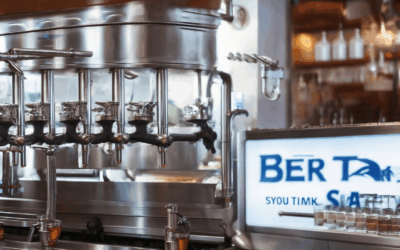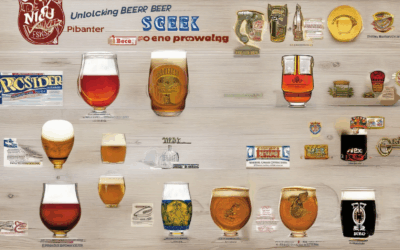In today’s competitive beverage industry, crafting a compelling beer value proposition is crucial for brewers aiming to stand out. A value proposition serves as the core message that communicates what makes one product or service better than its competitors. For beers, this proposition often revolves around taste, quality, innovation, or unique selling points that resonate with consumers. Whether it’s through award-winning flavors, sustainable practices, or storytelling tied to heritage, every brewer has the opportunity to craft a value proposition that captures the essence of their brand. This article delves into the intricacies of beer value propositions, exploring examples, comparing them to other beverages like wine, and examining historical and modern concepts that shape brewing strategies. By understanding the fundamentals of value propositions and applying them thoughtfully, brewers can create offerings that not only appeal to discerning palates but also drive brand loyalty and market success.

Example of a Value Proposition
A value proposition is a statement that communicates the unique benefit or advantage of a product, service, or brand to its target audience. It helps potential customers understand why choosing one option over others is the best decision.
For instance, consider a coffee shop that positions itself as offering “fresh, handcrafted beverages in a cozy, inviting atmosphere.” This value proposition emphasizes quality, personalization, and customer experience, setting it apart from competitors who may focus solely on price or convenience.
Key Components of a Strong Value Proposition
- Clarity: Clearly articulate the benefit or solution the customer will receive.
- Unique Selling Point (USP): Highlight what makes the offering different and better than alternatives.
- Target Audience: Tailor the proposition to the specific needs and preferences of the intended customers.
- Emotional Appeal: Connect with the customer on a emotional level, making them feel understood and valued.
How to Develop a Value Proposition
- Identify Customer Needs: Conduct market research to understand the pain points and desires of your target audience.
- Highlight Unique Features: Pinpoint what makes your product or service unique and how it solves problems others can’t.
- Test and Refine: Continuously test different propositions through surveys, feedback, and A/B testing to find the most effective one.
By focusing on these elements, businesses can create a compelling value proposition that resonates with their audience and drives long-term success.
The 3:30-300 Rule for Beer
The 3:30-300 rule for beer refers to maintaining the optimal temperature range for serving beer, typically between 33°F (0.56°C) and 50°F (10.16°C). This range ensures that beer is cold enough to enhance its flavor and carbonation without becoming too cold, which can mask flavors and textures.
Serving beer at this temperature range is crucial for several reasons:
- Flavor Enhancement: Beer flavors are more pronounced at cooler temperatures, allowing hop bitterness and malt character to shine through. This is particularly important for lagers and pilsners, which are known for their crispness and hop-forward profiles.
- Carbonation Maintenance: Proper temperature controls help maintain the fizziness and carbonation of beer, contributing to a smoother mouthfeel and preventing it from tasting flat or harsh.
- Glassware Choice: The type of glass used can also influence the beer’s appearance and aroma. For example, a tulip glass helps retain the head and aroma, while a snifter is ideal for capturing the nose.
- Serving Pressure: Maintaining the correct pressure ensures that beer is well-carbonated and foamy, enhancing the overall drinking experience.
Experiment with different temperatures to find what suits your personal preference, as every palate is unique. This rule is a helpful guideline, but ultimately, the enjoyment of beer lies in savoring its nuances and sharing it with others in a comfortable setting.

The Value Proposition of Wine
Wine offers a multifaceted value proposition that extends far beyond its role as a beverage. Its appeal lies in several key dimensions:
- Health Benefits : Wine, particularly red wine, contains antioxidants like resveratrol, which may contribute to cardiovascular health. Moderate consumption can have positive effects on heart health, providing a health-conscious benefit.
- Social and Cultural Significance : Wine is deeply rooted in social traditions, often associated with celebrations, meals, and gatherings. It fosters a sense of camaraderie and enjoyment, making it a central element in social interactions.
- Variety and Regional Distinctiveness : The vast array of wine varieties, each reflecting its terroir, caters to diverse preferences. From the crispness of Sauvignon Blanc to the rich complexity of Burgundy, wine offers something for every palate, ensuring satisfaction for enthusiasts and newcomers alike.
- Culinary Pairing Expertise : Wine’s compatibility with food is a significant asset. Chefs and sommeliers meticulously match wines with dishes, enhancing dining experiences and offering educational value for those seeking to elevate their culinary encounters.
- Craftsmanship and Production Quality : The winemaking process, involving fermentation and aging, showcases artisanal skill. High-quality wines are often crafted with precision, appealing to those who appreciate fine craftsmanship and excellence.
- Versatility Across Occasions : Wine adapts to various settings, from casual drinks to formal dinners, and even as ingredients in cooking, adding versatility to its use cases.
- Investment Potential : Certain wines, especially those from renowned regions or vintages, can appreciate in value over time, attracting collectors and investors.
These factors collectively position wine as a premium product with broad appeal, satisfying both immediate sensory desires and deeper aspirations related to health, culture, and lifestyle.

Understanding Plato Value in Beer
The Plato value, often referred to as degrees Plato (°P), is a crucial measurement in brewing that quantifies the concentration of extract in beer wort. Extract consists primarily of fermentable sugars derived from malt but also includes other soluble materials. This measurement is expressed as a percentage by weight, indicating how many grams of extract are present in 100 grams of wort.
For example, a 10°P wort contains 10 grams of extract per 100 grams of wort. This value plays a significant role in determining the sweetness, body, and overall character of the beer. A higher Plato value typically results in a sweeter beer with a fuller body, while a lower value may lead to a lighter, less sweet beer.
In the brewing process, controlling the Plato value is essential for achieving the desired balance in flavor, aroma, and mouthfeel. Brewers manipulate variables such as malt selection, mash temperature, and boil conditions to adjust the extract concentration, ultimately influencing the final product’s profile.
Understanding and managing the Plato value is fundamental for both professional brewers and homebrewers aiming to craft beers with distinct characteristics. It is a key factor in ensuring consistency and quality across different batches and styles.
The Four Values of Plato
Plato, the ancient Greek philosopher, articulated four cardinal virtues, which are derived from his division of the human soul into three parts: reason, spirit, and appetite. Each part corresponds to a specific virtue:
- Wisdom (Sophia) : This is the virtue of reason, which Plato considers the most important. It involves the pursuit of knowledge and understanding, guiding individuals toward making wise decisions.
- Courage (Androcles) : Associated with the spirited part of the soul, courage entails the strength to act justly and勇敢地面对挑战,即使面对恐惧。
- Temperance (Dioskouri) : Relating to the appetitive part, temperance involves moderation and self-control, ensuring that desires are balanced and not excessive.
- Justice (Eunomia) : Justice is achieved when there is harmony among the three parts of the soul, leading to fairness and equality in social interactions.
These virtues collectively guide individuals toward living a just and virtuous life, reflecting Plato’s belief in the importance of moral and intellectual development.

Beer-Lambert Values Explained
The Beer-Lambert law is a fundamental principle in chemistry and biochemistry that relates the absorption of light by a solution to its composition. The law is expressed by the equation:
A = εbc
Where:- A is the absorbance of the solution,- ε (epsilon) is the molar absorptivity (also known as the extinction coefficient),- b is the path length through the sample,- c is the concentration of the absorbing species.
Key Components of the Beer-Lambert Law:
- Absorbance (A): This is a measure of how much light is absorbed by the solution. It is typically measured using a spectrophotometer.
- Molar Absorptivity (ε): This constant is specific to the particular substance and the wavelength of light being absorbed. It indicates the probability of the substance absorbing light.
- Path Length (b): This is the distance between the entry and exit points of the light beam passing through the solution.
- Concentration (c): This is the amount of the absorbing species in the solution, usually measured in mol/L (molarity).
Applications:
The Beer-Lambert law is widely used in various fields for measuring concentrations of substances. Common applications include:- Pharmaceutical Analysis: To determine the concentration of drugs in solutions or suspensions.- Environmental Testing: To measure concentrations of pollutants in water or air samples.- Food Chemistry: To analyze the concentration of additives or contaminants in food products.
Considerations:
- The law assumes that the solution is homogeneous and that there is no significant light scattering.
- Temperature can affect the accuracy of measurements, as both ε and c may change with temperature.
- Proper calibration of the spectrophotometer is essential for accurate results.
This simple yet powerful relationship underpins many analytical techniques, making it indispensable in modern scientific research and industrial quality control.





0 Comments